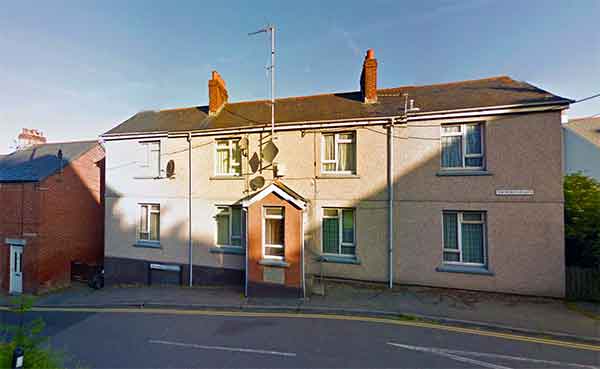.
Launceston like most towns during the 20th century had acute housing problems with many in a sad slum state as well as having a low stock of available housing for a rising population. These problems became more critical after the First World War, with many believing that the returning men should have homes fit for the heroes from such a dreadful war. Thomas Nicolls had been a prominent businessman in the town and for a short time a town councillor. After a short illness, he passed away in February 1917. In his will, he left a legacy of £900 to the town council to build model cottages for thirty ‘sober’ working men or women. In 1924 the legacy was spent on tenement houses for the elderly that were built at Western road in his memory at the junction of Chapple. The houses had cost the town council £1,126, leaving the council a further £226 to fund the build themselves. At the August 1924 housing committee meeting the minutes stated that: ‘It was reported that each tenement had been assessed at £4 gross and £3 rateable. It was agreed to pay the Surveyor £20 for his services in connection with this building. Resolved to let the houses as from last September 1924, the Surveyor reporting that the building would then be ready for occupation. The rents were fixed at 2s 6d per week for the two upstairs tenements, and 2s 9d per week for the two downstairs tenements, the tenant to pay rates and each tenant to have fourth part of existing garden, and the tenants to be informed that the rents may have to be reconsidered at the end of the first twelve months.’
‘The Mayor said he should like to make a statement to show why it was necessary to charge rents such as 2s 6d and 2s 9d, which he wanted to suggest should be 2s 9d all round. He would like to make it clear why they had to charge 2s 9d rent for a house largely considered as a gift house. Whilst, of course, it was largely a gift house, it was not entirely so. The house cost them £1,126. Mr Nicolls’s gift net was £900, and there would have accrued to that some little interest since the money was paid into the bank so that the actual cost to the council over and above Mr Nicolls’s gift was £226. That, of course, had to be provided for by way of interest on the loan and repayment of principal, and £226 at 4 1/2 per cent interest and 1 1/2 per cent repayment made a standing charge of £13 12s for that item alone. They had to pay income tax on the house, which was something like £4 10s, and other items were insurance, repairs, voids, and establishment charges, which they had estimated at £10 10s per year, which he ventured to suggest was by no means an extravagant estimate. It stood to reason that no part of that house must come out of the rates, that the people living there must pay the actual out of pocket expenses. The sums he had mentioned made a standing charge of £28 12s, and if they charged a rental of 2s 9d a week for upstairs as well as downstairs, that brought them in £28 12s, so that anything less than 2s 9d would show an actual loss, and involve a charge on the rates. The adoption of the minutes was agreed to, with the exception that the rent throughout the house was to be 2s 9d, subject to revision at the end of twelve months.’
At the very same meeting in August 1924, the proposed new housing scheme for 10 houses on Race Hill was discussed. Various alterations and deductions were suggested, and it was decided that the Surveyor would make the necessary amendments to the plans and specifications and that if the total cost of building did not exceed £310 per house, slate roofs should be submitted for asbestos tiles and that the contractors should be asked to meet the Housing Committee and make final arrangements. At a subsequent meeting, the Mayor reported that the contractors (Messrs Admas, Quick and Kinsman) of the proposed 10 houses on the Trelawney Site had met the sub-Committee on August 6th, when Mr R. Adams submitted an amended tender of £3,297 10s for the mason’s work substituting slate roofs for asbestos tiles. Mr Quick said he was unable to reduce his tender of £1,450 for the carpenter’s work. Mr Kinsman said he would provide and fix 5ft porcelain bath complete with brass plug and washer and 1 1/2 inch lead waste pipe carried to outside gulley trap for £5 19s per house. If with japanned bath £4 9s per house or a zinc bath with two coats of bath enamel fixed completely for about £2 per house. The sub-Committee estimated that even if the cheapest kind of bath were provided the total cost per house would be approximately £311. It was recommended subject to the approval of the Ministry of Health, that the Council should accept Mr Kinsman’s tender to supply and fix porcelain baths at £5 19s per house and to carry into the estimate a sum of £2 per house for lighting. The tenders of Mr Adams and Mr Quick were also accepted.
9250
Visits: 170

